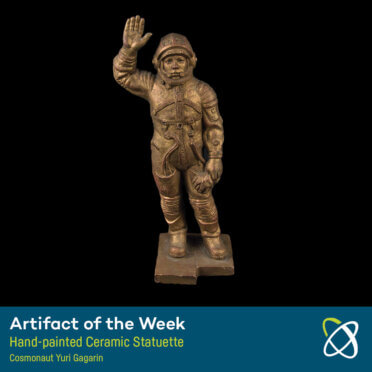Hand-painted Ceramic Statuette – Cosmonaut Yuri Gagarin
Today we celebrate the International Day of Human Space Flight with this statuette of the very first human in space. On April 12, 1961, Russian cosmonaut Yuri Gagarin launched into space aboard the Vostok 1 spacecraft. He spent 108 minutes in space, orbiting the Earth at a speed over 17,000 miles per hour. During reentry, Gagarin ejected from Vostok and landed by parachute, earning his place in history.

Yuri Gagarin, the first human in space, was more than a brave pioneer in human history. He was also a powerful propaganda tool for the Soviet Union.
Once the Soviet Union began focusing their space program on launching a human being into space, a secret nationwide selection process began. In 1960, Gagarin and 19 other pilots from the Soviet Air Force service were chosen for the first group of cosmonauts. This group was further cut down to a group of 6 pilots, the “Sochi Six,” an elite training group who were designated as the first cosmonauts of the Vostok program. Part of the selection process to go from that 20 to 6, and then from 6 down to a single man for the first launch, was based on physical and psychological endurance as well as performance during training. However, there was more to the selection than technical skill and medical fitness.
The USSR’s leadership understood that if the mission was successful, if they could launch the first human into space, that cosmonaut would become the most recognized face around the world. This meant he would be a weapon of power politically, so he needed to be appealing when presented to the world. Yuri Gagarin, the charming, easygoing Russian with a ready smile fit that criterion, but it was his smile that clinched his selection as the first to go to space. It was said that his smile could melt even the stoniest of hearts, including those at the highest levels of power in the Soviet Union. And when presented to the world, his dazzling smile and charisma quickly won over the hearts and minds of people the world over, despite political alignments during the continuing Cold War. He embarked on a world tour and was celebrated by huge crowds, dignitaries, and world leaders.
The Soviet Union couldn’t have asked for a better propaganda tool. Gagarin was a much more appealing face for communism, and his humble roots story of “carpenter to cosmonaut” made him a figure of bravery, strength, and endurance. The Soviets used his story to represent the nation’s journey to that point; the USSR was a model for new nations, able to overcome adversity (like a devastating world war and decades of technological deficiency) to achieve the greatest feat in human history. Gagarin’s immense popularity ensured that their message was communicated far and wide.
See more Artifacts of the Week
Artifact of the Month Video Series
Connect with curiosity!










